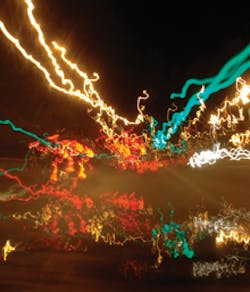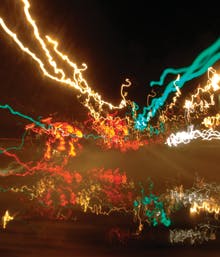Burnout: There is a sure cure.
by Kristen LeClair, RDH, BA
It was mid-March when a colleague and I were on our way to a fabulous two-day continuing-education course in Napa, Calif. While driving up Highway 29 in the early hours of the day, a silhouette of two hot air balloons drifted in the sky against the majestic rolling hills. To the left were two more hot air balloons, their colors brilliantly ablaze in the newly rising sun. Although our drive was only an hour, the ability to share stories, both professional and personal, with my dental hygiene friend was just the beginning of what I knew was going to be a memorable weekend. One topic of discussion during this commute was professional burnout.
Job burnout is something most of us have heard about, but may not really know what it is. It is defined in the dictionary as “exhaustion of physical or emotional strength or motivation, usually as a result of prolonged stress or frustration.” Signs of burnout can be “depression, lack of energy, lack of desire, decreased productivity, increased absences and/or tardiness, abuse of alcohol/drugs, boredom, anger/resentment in the workplace, sleep problems, and the inability to relax” (www.careercoachinc.com). Not everyone who experiences burnout will exhibit these signs; they are merely a guideline.
After graduating from Washington state’s Shoreline Community College in 1993, I slowly began my clinical dental hygiene career while raising a young family. By the time my two sons were in grade school, I picked up my professional pace just enough to balance it with my home life. Fast forward to a more arduous time in life when, due to family circumstances, my income was no longer a commodity; it was a necessity. As grateful as I am to be in a profession with so much flexibility, working four to five clinical days a week became a burden in part due to the physical demands of this career. (Getting older didn’t seem to be helping either!) But there was more to it than just physical ailments. The body aches were accompanied by multifaceted feelings of “being stuck,” which led to feelings of exhaustion, frustration, and lack of motivation. Repetitive schedules, repetitive motions, and repetitive “flossing lectures” began to make me feel like I was on a treadmill in a really dingy gym. As far as dental hygiene body aches go, I have my loupes, my headlight, and some very helpful information on proper ergonomic practice, but it’s an ever toilsome effort worth every ounce of work. Recognizing our own job burnout is an important first step to “curing” it, but until we can see there is a problem, there isn’t one.
Identifying the cause of our discontent isn’t always easy, especially when we’re so busy “doing” and seldom find time for just “being.” Something as simple as going for a walk alone or sitting in a quiet place can be enough to allow some concrete clues to surface about what we may really be thinking or feeling. Reading and journaling are also productive ways to gain new perspectives. Staying in tune with how we feel at work and looking for a pattern to these feelings can help us determine the triggers to our burnout. Perhaps some clinical hygienists are in constant burnout, but my personal experience is such that some times are better than others; some days I’m absolutely content.
Having recognized the ebb and flow of my energy for my beloved clinical career, I too had to allow time for self-searching to find out what the main disconnect was. Over time, I discovered that my deepest professional disappointment was lack of learning and too much redundancy. Everything about my job had become “been there, done that.” The bladder chatter, neck pinch, arm squeeze, and hip tweaks had begun to take precedence in my thoughts during the workday. I was bored and resentful about having to continue on this way because dental hygiene is what I DO. But as my mother used to say: “When life gives you lemons, make lemonade.”
So there I was with my bucket full of lemons and a sour puss. It was then I realized I had a choice to make: sit in the acid and decay, or take the necessary action to change. I like to consider myself a wise person, so I chose the latter. OK, the truth is, I wanted to feel better about my career; after all, I spend more time at work than I do at most other things. While recognizing a problem and acknowledging a choice is helpful, it doesn’t solve anything on its own. That’s like recognizing a door and acknowledging that it’s locked ... but it still needs a key to be opened. Because “lack of learning” and “redundancy” are broad categories, I needed to ask myself some pertinent questions to bring more clarity to the situation. Questions that came to mind were: What do I want to be learning? Where can I learn this? Can I apply this knowledge in my workplace? How can I add some variation to my clinical day so it doesn’t feel so redundant? How can all this benefit my patients? The answers that followed came only through taking time out to hear myself think.
Lifelong learning is a passion of mine. Anything we have a passion for takes time and commitment, yet it’s necessary to schedule that time to keep our embers aglow and avoid burnout. I’ve determined that my topic of choice doesn’t have to be dentistry; I can read (and learn) what I want, when I want. For those of you familiar with Zig Ziglar, he’s an advocate for the “Automobile University,” which means listening to books on tape during commute time - a perfect idea for those of us who work full time and love to learn! The more I learn, the more I have to talk about with my patients, and the more confident I am with my communication skills in general.
Variation in dentistry can be challenging from day to day. Naturally, there are practices that utilize a wide variety of treatments, but for those of us in a “traditional” setting, spicing up the routine can be difficult. Succumbing to this truth, I looked at my attitude (my sour puss) and decided to work on that. With the recent buzz about The Secret by Rhonda Byrne, I read this book and took out of it what works for me. Ms. Byrne states, “Your current reality or your current life is a result of the thoughts you have been thinking. All of that will totally change as you begin to change your thoughts and your feelings.”
Sound simple? It is, and it works.
Over the past couple of years, I’ve participated in an online dental hygiene resource called Amy’s List (www.amysrdhlist.com). This forum is a place to go not only for professional camaraderie, but to develop truly caring relationships among the “Listers.” I was pleased to be able to meet several of these “Listers” in Napa. These individuals solidify my belief in the power of supporting one another by sharing our professional good times as well as the not-so-good times. This type of shared inquiry takes my professional perspective to an entirely new level.
In Napa, I found a group of committed, caring professionals interested in keeping their careers alive through mutual sharing and learning. Our highly knowledgeable speakers in the dental field are continually staying abreast of new information, and they deliver their messages to us with humor and grace. They take on the hard work of doing detailed research and giving it to us in a nutshell with additional resources so we can do more research on our own if we’re so inclined. This gives me direction in the continued education of dental hygiene, which is ever-changing. Just when I think I’ve heard it all, a completely new way of looking at a particular topic is born.
This “sure cure” for dealing with burnout is only as good as the effort behind it. Will going to outstanding weekend continuing-education courses keep me from ever feeling exhausted, frustrated, and undermotivated in my clinical profession? Probably not, but since I’ve identified my own source of burnout (at least this time around), I understand that if I don’t participate in such opportunities, my enthusiasm will again decline, leaving my patients at risk of having a burned-out clinician and leaving me very bitter and unfulfilled.
Much like those hot air balloons in Napa, if we recognize job burnout in ourselves, we have a choice. We may choose to be like the silhouette of the hot air balloon, performing our duties without being fully present, or we may choose to be like the balloon with its colors brilliantly ablaze as we strive for continued excellence.
The commute home from Napa with my colleague/dear friend gave us the opportunity to recap the weekend courses and fun times shared with some of this profession’s finest. Burnout may come and go, but memorable weekends such as these can, and will, breathe life into our career. As I think about my journey through professional dental hygiene, I wouldn’t change a thing. I’ve learned so much and continue to do so even through the periods of burnout. In fact, it has been said that we grow the most during life’s rough patches. Thank goodness I have tools to use and a special network of colleagues to help me during those times.
Bombarding Burnout
- Identify the cause by taking time out for yourself.
- Take a quiet walk alone.
- Sit in your favorite place for a while, undisturbed.
- Read.
- Journal.
- Stay in tune with how you feel at work.
- Listen to your inner feelings.
- Once identified, take action!
- Decide to make change happen.
- Ask yourself pertinent questions.
- Do an attitude check.
- Seek information to help via books, CDs and CE courses.
- Network with other hygienists.
- Never forget how hard you worked for your professional license, and realize there are so many others out there who would love to walk in your shoes.
Kristen LeClair, RDH, BA, began her career in dentistry 23 years ago - first as a certified dental assistant, then as a registered dental hygienist. She holds a business management degree from St. Mary’s College in Moraga, Calif., and has a solid understanding of dentistry as a business. Kristen currently practices clinical dental hygiene in Berkeley, Calif., while pursuing writing and speaking. Her passion is education - both gaining and sharing.

